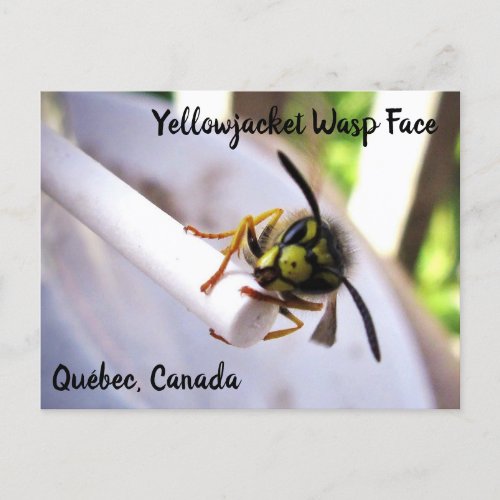Yellowjacket Wasp (Vespulae) Cute Face Postcard



What's cute about wasps? This female yellowjacket or yellow jacket (subfamily Vespinae) has such a cute face! She's out collecting sugary fluids like the residue on a lollipop stick. This wasp portrait is done in slight soft focus, like a 1940s movie star. You can change or delete the writing if you like. Yellowjacket wasps can build enormous nests out of wood and plant fibers chewed up and mixed with wasp saliva to create a water-resistant grey or brown papery substance similar to papier mache. Female wasps build combs and cells from the material. <br /><br /> Wasps have a bad reputation in the human sphere, but I've been feeding these animals for three summers now and have learned a lot about them! At the wasp feeder we also get European paper wasps, northern or golden brown paper wasps, bald-faced hornets - not true hornets, these large wasps with pale yellow or white markings are more related to yellowjackets. Females of any species can pack a mighty sting, but they usually don't want to. They use the sting as a last resort or emergency, for instance if someone gets a yellowjacket in the mouth due to not checking food or beverage before eating or drinking it (yeh this happened to me, twice. Then I learned.) A wasp is careful how she uses her stinger because it is also her ovipositor - she needs it to lay eggs, and if it's damaged she can't reproduce. Besides the queen, worker wasps can also lay eggs, which are often destroyed by the queen or her loyal troops. But if the queen dies, other dominant females step forward and fight to win the egg-laying race. Wasp behavior is often misunderstood, and the first reaction from the human mind is panic. Many people have phobias about wasps and bees, based on primal fears. However, when single wasps approach humans they are not trying to sting. They're a) curious - these insects are intelligent; or b) hungry - the humans have food. In late summer, when all eggs have hatched, and all larvae have either pupated or have been destroyed, there's no more food at the nest. Normally wasps feed insects to their larvae, who produce a sweet liquid which the wasps consume. Adult wasps cannot digest meat or solid food. By the time they're pestering barbecue guests, the wasp has only a month or two to live, unless she's a queen, who overwinters to start a new colony in spring. These wasps are considered aggressive but the only time they go on the attack is in defence of the yellowjacket colony, or if they perceive a personal attack - for instance if a person is yelling and swatting at them. Sudden reactions arise out of fear, and this can get people stung. Calm is essential. A wasp may also land on a person because the insect is tired or cold, and just needs a moment to recover. It will soon fly off. One or two wasps are no big deal. They are beneficial insects which hunt garden pests. However, if you're ripping apart old buildings, trees or wood piles, beware! The wasps rise in a buzzing swarm to protect their home from your destructive invasion, and then you are really in trouble. Better jump in a lake. Nests can house hundreds and thousands of these stinging insects. Basic wasp safety includes handling old dead wood, attics or woodpiles with care, because these are favorite nesting sites of yellowjacket wasps and also European hornets, which are true hornets and can resemble very large yellow jackets. Yellowjackets are often mistaken for bees, but are true wasps. They can be difficult to identify at a glance because they occur in various shapes and sizes, from small workers, which are the first to hatch from eggs laid by the Queen, to large workers, to drones (males) and princesses or queens. Many yellowjackets have a black dot, dotty pattern or other black markings on the yellow face plate, which identifies them to other wasps of their colony. Like other species of social wasp, there is a strong dominance heirarchy among yellowjackets. Facial markings and body patterns may correspond to dominant or subordinate roles. <br /><br /> This image is great for anyone into cute insects, wasps, yellow jacket wasps especially; flying insects, stinging insects, insects of North America, wildlife and nature. Cute yellow jacket wasp face image by M Sylvia Chaume, Canada.


